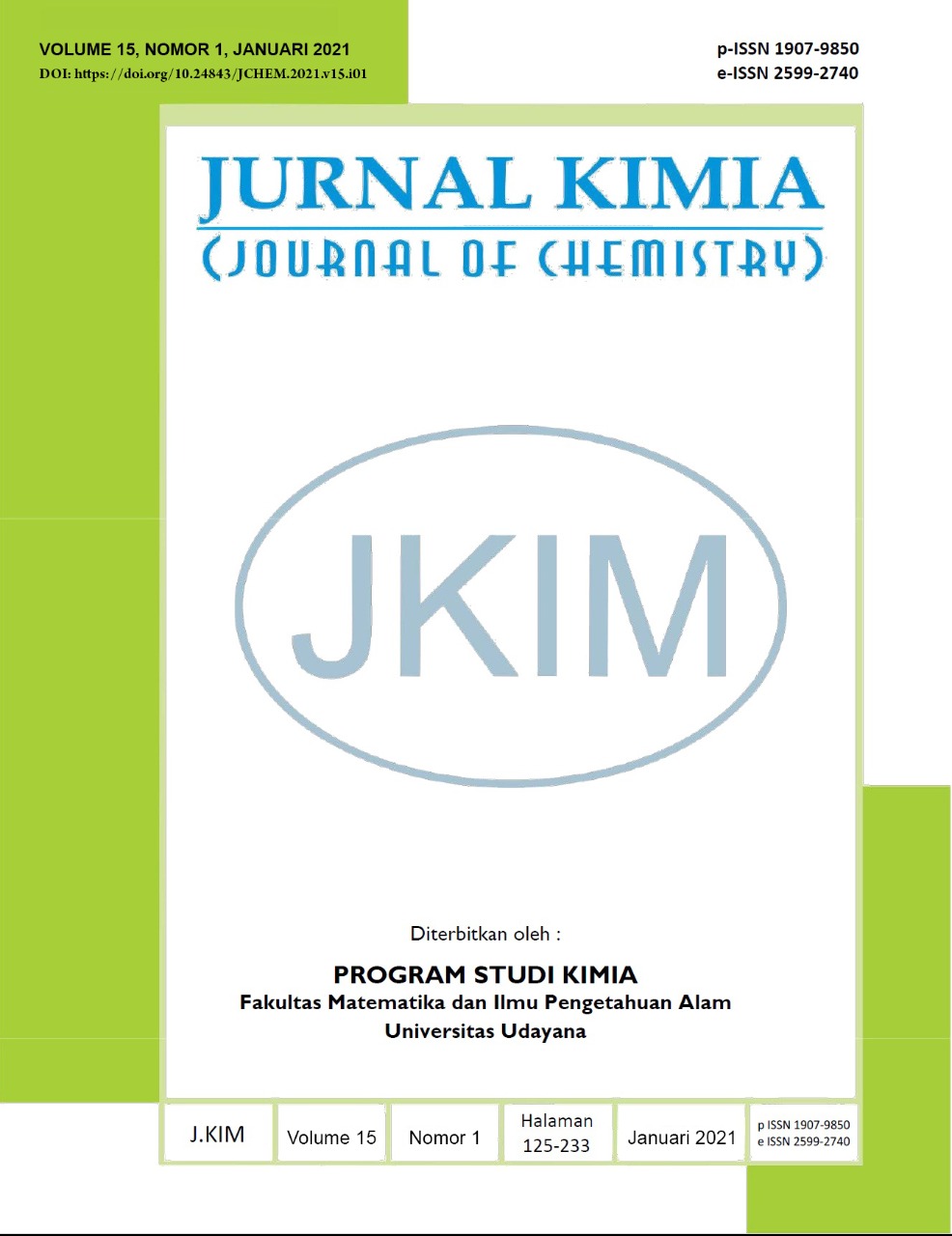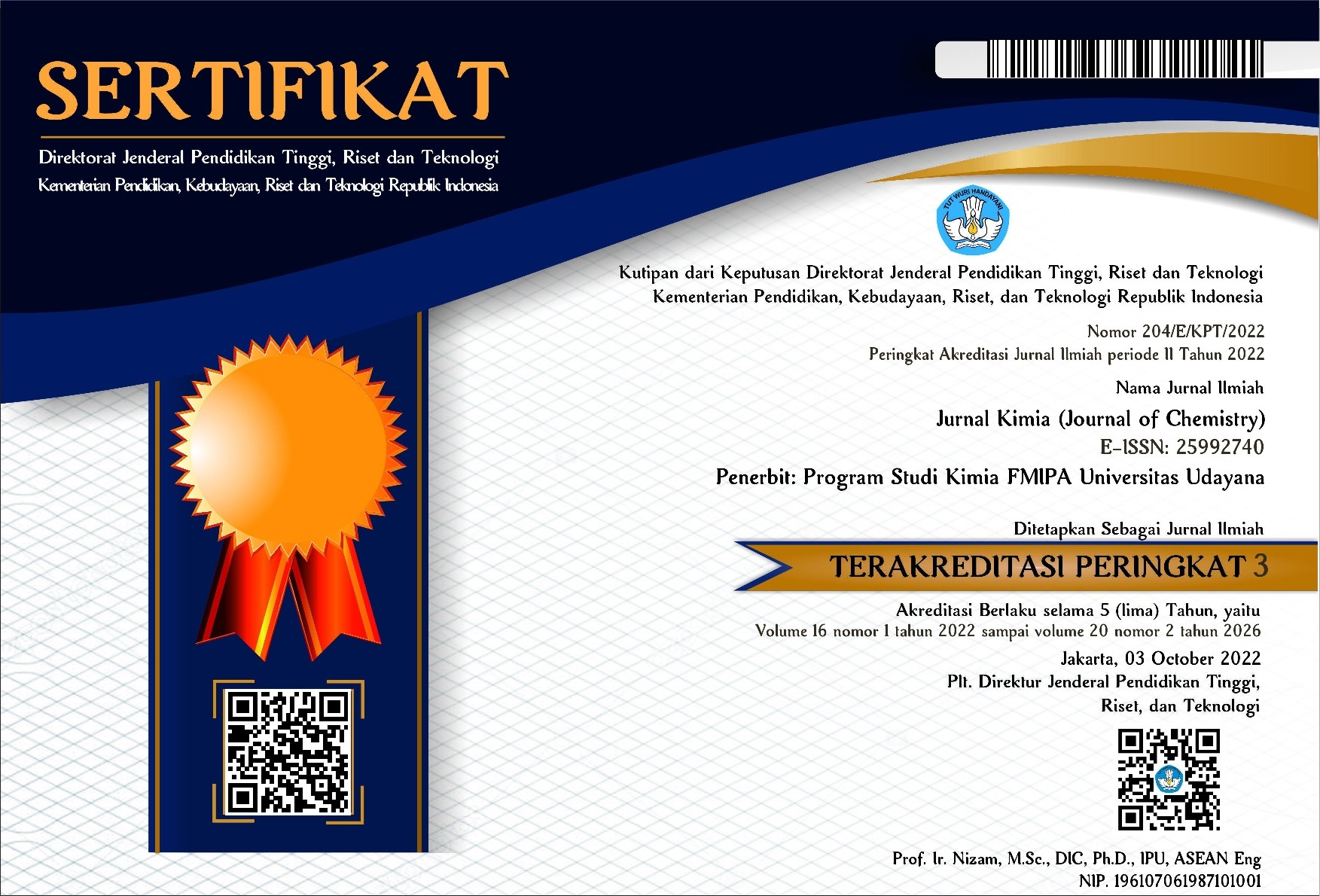STUDI INTERAKSI SENYAWA KOMPLEKS BESI TERHADAP PROTEIN HEMOFOR PADA PSEUDOMONAS AERUGINOSA (HasAp) SECARA IN SILICO
Abstract
Sebuah protein hemofor yang dihasilkan oleh Pseudomonas aeruginosa (HasAp) dapat mengikat beberapa senyawa kompleks logam selain Protoporfirin-IX (heme). Struktur kristal dari protein HasAp yang mengandung senyawa kompleks logam hanya menunjukkan sedikit perubahan pada keseluruhan struktur protein HasAp. Fe-ftalosianina (Fe-Pc) dan Fe-mesoporfirin-IX (Fe-MPIX) mampu menghambat protein HasAp yang terikat heme sebagai sumber zat besi. Pada penelitian ini akan dilakukan identifikasi, evaluasi, dan eksplorasi terhadap mekanisme aksi dari senyawa Fe-Pc dan Fe-MPIX terhadap protein HasAp, serta mengamati pengaruhnya pada bagian sisi aktif protein HasR dengan menggunakan studi in silico. Simulasi penambatan molekuler berbasis protein-ligan dilakukan dengan menggunakan perangkat lunak MGLTools 1.5.6 yang dilengkapi dengan AutoDock 4.2 untuk mengamati afinitas dan interaksi molekuler yang terbentuk antara molekul senyawa Fe-Pc dan Fe-MPIX terhadap makromolekul protein HasAp. Kemudian dilakukan simulasi penambatan molekuler berbasis protein-protein terhadap sistem kompleks protein-ligan untuk mengamati pengaruhnya terhadap area pengikatan dari makromolekul protein HasR dengan menggunakan perangkat lunak PatchDock. Hasil simulasi penambatan molekuler berbasis protein-ligan menunjukkan bahwa senyawa Fe-MPIX memiliki afinitas yang lebih baik dari senyawa Fe-Pc pada makromolekul protein HasAp-FeMPIX, dengan nilai energi bebas ikatan masing-masing ?65,73 kJ/mol dan ?63,97 kJ/mol. Kemudian, hasil simulasi penambatan molekuler berbasis protein-protein antara kompleks senyawa Fe-MPIX dan protein HasAp-FeMPIX terhadap protein HasR memiliki nilai atomic contact energy (ACE) paling positif, yaitu 1051,44 kJ/mol. Perbedaan ukuran struktur molekul senyawa terbukti mampu mempengaruhi mekanisme aksi terhadap protein target. Dengan demikian, diperlukan kehati-hatian dalam mendesain molekul senyawa inhibitor dari protein HasAp secara in silico.
Kata kunci: Fe-ftalosianina, Fe-mesoporfirin-IX, protein HasAp, protein HasR, Pseudomonas aeruginosa
A hemophore protein produced by Pseudomonas aeruginosa (HasAp) can bind several metal complex compounds besides Protoporphyrin-IX (heme). The crystalline structure of the HasAp protein-containing metal complex compounds shows only slight changes in the overall structure of the HasAp protein. Fe-phthalocyanine (Fe-Pc) and Fe-mesoporphyrin-IX (Fe-MPIX) can inhibit heme-bound HasAp proteins as a source of iron. In this research, identification, evaluation, and exploration of the mechanism of action of Fe-Pc and Fe-MPIX compounds on HasAp protein will be performed, as well as observing their effects on the active site of HasR protein through in silico studies. Protein-ligand docking simulations were conducted using MGLTools 1.5.6 software with AutoDock 4.2 to observe the affinity and molecular interactions formed between molecules of Fe-Pc and Fe-MPIX compounds on HasAp protein macromolecules. Then a protein-protein docking simulation was performed on a protein-ligand complex system to observe its effect on the binding area of ??the HasR protein macromolecules using PatchDock software. Protein-ligand docking simulation results show that the Fe-MPIX compound has a better affinity than the Fe-Pc compound in HasAp-FeMPIX protein macromolecules, with binding free energy values ??of ?65,73 kJ/mol and ?63,97 kJ/mol, respectively. Then, the simulation results of protein-protein docking between the complexes of Fe-MPIX compound and HasAp-FeMPIX protein to HasR protein have the most positive atomic contact energy (ACE) score, with the value of 1051,44 kJ/mol. The difference in molecular structure size of compounds can influence the mechanism of action on target proteins. Therefore, caution is needed in designing inhibitor compound molecules from HasAp protein through in silico.
Keywords: Fe-mesoporphyrin-IX, Fe-phthalocyanine, protein HasAp, protein HasR, Pseudomonas aeruginosa
Downloads
References
Arnoux, P., Haser, R., Izadi, N., Lecroisey, A., Delepierre, M., Wandersman, C., Czjek, M. 1999. The crystal structure of HasA, a hemophore secreted by Serratia marcescens. Nat. Struct. Biol. 6 (6): 516-520.
Aruleba, R.T., Adekiya, T.A., Oyinloye, B.E., Kappo, A.P. 2018. Structural studies of predicted ligand binding sites and molecular docking analysis of Slc2a4 as a therapeutic target for the treatment of cancer. Int. J. Mol. Sci. 19 (2): 386.
Forli, S., Huey, R., Pique, M.E., Sanner, M., Goodsell, D.S., Olson, A.J. 2016. Computational protein-ligand docking and virtual drug screening with the AutoDock suite. Nat. Protoc. 11 (5): 905-919.
Ghigo, J.M., Lettofe, S., Wandersman, C. 1997. A new type of hemophore-dependent heme acquisition system of Serratia marcescens reconstituted in Escherichia coli. J. Bacteriol. 179 (11): 3572-3579.
Idei, A., Kawai, E., Akatsuka, H., Omori, K. 1999. Cloning and characterization of the Pseudomonas fluorescens ATP-binding cassette exporter, HasDEF, for the heme acquisition protein HasA. J. Bacteriol. 181 (24): 7545-7551.
Jepkorir, G., Rodriguez, J.C., Rui, H., Im, W., Lovell, S., Battaile, K.P., Alontaga, A.Y., Yukl, E.T., MoenneLoccoz, P., Rivera, M. 2010. Structural, NMR spectroscopic, and computational investigation of hemin loading in the hemophore HasAp from Pseudomonas aeruginosa. J. Am. Chem. Soc. 132 (28): 9857-9872.
Krieg, S., Huche, F., Diederichs, K., Izadi-Pruneyre, N., Lecroisey, A., Wandersman, C., Delepelaire, P., Welte, W. 2009. Heme uptake across the outer membrane as revealed by crystal structures of the receptor-hemophore complex. Proc. Natl. Acad. Sci. U.S.A. 106 (4): 1045-1050.
Kumar, R., Lovell, S., Matsumura, H., Battaile, K.P., Moenne-Loccoz, P., Rivera, M. 2013. The hemophore HasA from Yersinia pestis (HasAyp) coordinates hemin with a single residue, Tyr75, and with minimal conformational change. Biochemistry. 52 (16): 2705-2707.
Kurniawan, F., Miura, Y., Kartasasmita, R.E., Yoshioka, N., Mutalib, A., Tjahjono, D.H. 2018. In silico study, synthesis, and cytotoxic activities of porphyrin derivatives. Pharmaceuticals. 11 (1): 8.
Letoffe, S., Deniau, C., Wolff, N., Dassa, E., Delepelaire, P., Lecroisey, A., Wandersman, C. 2001. Haemophore-mediated bacterial haem transport: evidence for a common or overlapping site for haem-free and haem-loaded haemophore on its specific outer membrane receptor. Mol. Microbiol. 41 (2): 439-450.
Letoffe, S., Ghigo, J.M., Wandersman, C. 1994. Iron acquisition from heme and hemoglobin by a Serratia marcescens extracellular protein. Proc. Natl. Acad. Sci. U.S.A. 91 (21): 9876-9880
Letoffe, S., Omori, K., Wandersman, C. 2000. Functional characterization of the HasAPF hemophore and its truncated and chimeric variants: determination of a region involved in binding to the hemophore receptor. J. Bacteriol. 182 (16): 4401-4405.
Letoffe, S., Redeker, V., Wandersman, C. 1998. Isolation and characterization of an extracellular haemBinding protein from Pseudomonas aeruginosa that shares function and sequence similarities with the Serratia marcescens HasA haemophore. Mol. Microbiol. 28 (6): 1223-1224.
Morris, G.M., Goodsell, D.S., Halliday, R.S., Huey, R., Hart, W.E., Belew, R.K., Olson, A.J. 1998. Automated docking using a Lamarckian genetic algorithm and an empirical binding free energy function. J. Comput. Chem. 19 (14): 1639-1662.
Prabhu, D.S., Rajeswari, V.D. 2016. In silico docking analysis of bioactive compounds from Chinese medicine Jinqi Jiangtang Tablet (JQJTT) using Patch Dock. J. Chem. Pharm. Res. 5 (8): 15-21.
Satake, Y., Abe, S., Okazaki, S., Ban, N., Hikage, T., Ueno, T., Nakajima, H., Suzuki, A., Yamane, T., Nishiyama, H., Watanabe, Y. 2007. Incorporation of a phebox rhodium complex into apo-myoglobin affords a stable organometallic protein showing unprecedented arrangement of the complex in the cavity. Organometallics. 26 (20): 4904-4908.
Shirataki, C., Shoji, O., Terada, M., Ozaki, S., Sugimoto, H., Shiro, Y., Watanabe, Y. 2014. Inhibition of heme uptake in Pseudomonas aeruginosa by its hemophore (HasAp) bound to synthetic metal complexes. Angew. Chem. Int. Ed. 53 (11): 2862-2866.

This work is licensed under a Creative Commons Attribution 4.0 International License






